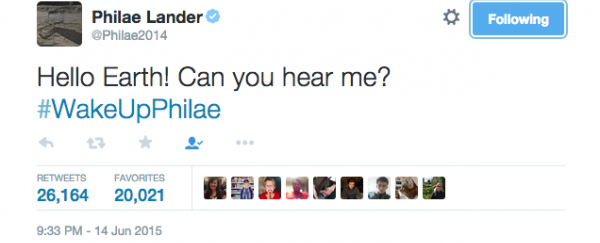After becoming the first spacecraft to successfully land on a comet, the German Aerospace Agency (DLR) has decided it's time to say goodbye to the Philae lander, as conditions on Comet 67P/Churyumov-Gerasimenko continue to make it harder and harder to re-establish connections. It's truly a sad day for all of us who fell in love with the lander on Twitter.
Though the lander has provided researchers with a plethora of data - over 60 hours of research in total - its journey was marred by issues. The first came about while trying to land on the comet's surface. Over the course of its 10-year, 510-million-kilometre adventure through space, Philae's harpoon system stopped working, which forced it to crash land on the comet and bounce into a shadowy area where it could not adequately recharge its solar batteries.
To make matters worse, the location of its landing drops routinely to 180 degrees Celsius at night - a temperature way colder than what Philae was designed for.
Without much light and with temperatures slowly destroying its instruments, Philae began to lose its connection to researchers. Though there were many times when Philae lost connection and late re-established it, sometimes after months of silence, the lander has been silent since its last transmission back in July 2015.
Now, according to DLR, it'a unlikely that Philae will ever come out of hibernation and they have decided to stop trying to contact it. However, Philae's communication board will remain switched on until it runs out of power. This means that it could send a signal though it's highly unlikely. It seems like leaving this mechanism on is really just to keep the hope alive, and who can blame them?
"Unfortunately, the probability of Philae re-establishing contact with our team at the DLR Lander Control Center (LCC) is almost zero, and we will no longer be sending any commands; it would be very surprising if we received a signal now," said Stephan Ulamec, the Philae Project Manager.
Though Philae's career is over, Rosetta, the ESA probe that carried the lander to Comet 67P/Churyumov-Gerasimenko, will remain orbiting overhead. It's a day of sadness for researchers all over the world and general public who fell in love with the Wall-E-like craft back in 2014 as it routinely tweeted about its mission.
It’s cold & dark on #67P & chances of communicating with @ESA_Rosetta are decreasing, but I won’t give up just yet. https://t.co/HAJIbi59KO
— Philae Lander (@Philae2014) February 12, 2016
So, in honor of the little lander that could, here are some of its best Twitter moments through its heroic, journey:
I have 60 million km to go. That's roughly the total distance run by every runner of the London marathon for the past 40 years combined.
— Philae Lander (@Philae2014) July 30, 2012
In 2007 we surprised some astronomers who mistook us for an asteroid passing by at 5,700 km. Then in 2009, we flew past again at 2,500 km :)
— Philae Lander (@Philae2014) February 13, 2013
.@MarsCuriosity You made it through your 7 MINUTES OF TERROR in 2012. My ~7 hr #CometLanding is just 7 days away. Any advice for a newbie?
— Philae Lander (@Philae2014) November 5, 2014
Save the date! In just one day, I’ll be saying farewell to @ESA_Rosetta for #CometLanding . #67P , I can’t wait to land on you…
— Philae Lander (@Philae2014) November 11, 2014
I’m in the shadow of a cliff on #67P. Where exactly? That’s what my team is in the process of finding out! #CometLanding
— Philae Lander (@Philae2014) November 13, 2014
Also my rotation was successful (35 degrees). Looks like a whole new comet from this angle:)
— Philae Lander (@Philae2014) November 14, 2014
Is anyone there? Am I speaking loud enough? #lifeonacomet
— Philae Lander (@Philae2014) July 10, 2015
